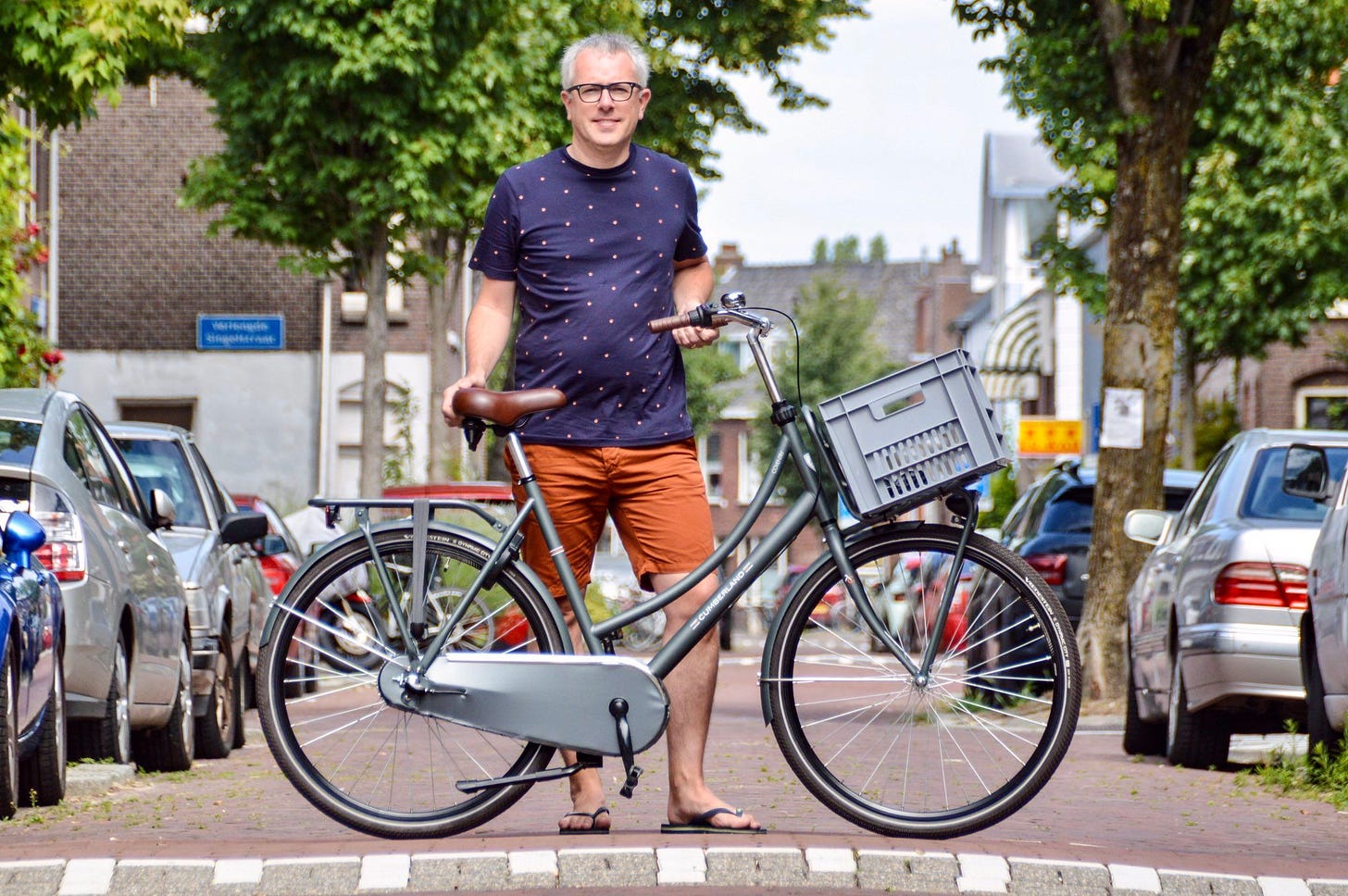Hi everyone,
What do bike lanes have to do with the future of work? You may think about the riders who deliver meals to well-to-do urbanites. Or about those same well-to-do creative class urbanites who choose to ride to work to reduce their carbon footprint. But this narrow vision tends to fuel a culture war around cycling that opposes rich, educated urban dwellers and others outside the city centre who largely rely on cars. This vision misses the point.
Our transport infrastructures support and mould the fabric of our society. They empower networks of relationships and clusters of talent. They enable numerous activities. They connect service workers (who often live in the periphery) to their place of work (often the city centre). But a lot of these infrastructures were not designed for everybody. The people who shaped them had factory workers and office employees in mind, not the service workers.
Like all infrastructures, bike lanes should be developed with all that in mind. When you look at the infrastructure decisions made in the Netherlands in the 1970s, you see that they were designed as very democratic and inclusive infrastructures: the old use them, people with disabilities use them, so do families with children. Cycling is cheap. And it has the potential to transform our (work) lives for the better.
That’s why I interviewed Chris Bruntlett for my Laetitia@Work podcast. He and his wife Melissa are urban mobility activists who wrote two best-selling books about cycling: Building the Cycling City and Curbing Traffic. A couple of years ago they moved from Vancouver, Canada to the Netherlands to fully embrace the cycling lifestyle. He even became the marketing director of the Dutch Cycling Embassy, a “vast network of public and private organisations from the Netherlands who wish to share their expertise on building what supports the Dutch cycling culture to those interested”.
👉 I loved this conversation so I’m very happy to share this podcast with you 🎧 ☝️
In this newsletter I also wanted to share a few thoughts on the relationship between bike lanes, the feminist city and the future of work 🚴👇💡
Last year I interviewed feminist geographer Leslie Kern after the publication of her book Feminist City. I even dedicated a whole newsletter to the subject: We need (feminist) cities. The first point addressed in this newsletter is that urban design isn’t “neutral”. As Leslie Kern wrote in her book:
“This simple statement of the fact that built environments reflect the societies that construct them might seem obvious. In a world where everything from medication to crash test dummies, bullet-proof vests to kitchen counters, smartphones to office temperatures, are designed, tested, and set to standards determined by men’s bodies and needs, this shouldn’t come as a surprise. (...) The continued underrepresentation of women in architectural and planning professions means that women’s experiences of and in these places are likely to be overlooked or based on outdated stereotypes.”
If vibrant cities are the future of humanity then we should make that future more inclusive, heed the poor who live at the periphery, those who care for others, and those who live outside it. If developing networks and relationships is essential in the future of work, then we should design our infrastructures in such a way as to make more diverse networks possible. One of the keys is to include care work in the reflection. As Chris and Melissa explain in their book:
“The danger is not considering care work and the trips required to perform it—or care trips—in the transportation planning landscape, is that the needs of a significant portion of the population are left unmet. Care trips are often undercounted or uncounted because they don’t fall into easily measured, quantifiable definitions. When you think of the average journey to drop kids off at school or daycare, stop at the grocery store, or visit the doctor’s office, they are generally less than a kilometer in distance and seldom take longer than 15 minutes. Most travel surveys fail to take these measurements into account due to their brevity, ultimately ignoring entire swaths of mobility patterns. At the same time, care trips are usually arranged in a polygonal spatial pattern—indirect and with multiple stops—covering smaller geographical areas that are closer to home and made on foot or public transport. From a data collection stance, these trips are harder to track than the average, single-purpose commute for employment.”
That is how I understand the now famous concept of the 15-minute city inspired by Carlos Moreno and popularised by Paris mayor Anne Hidalgo. Whether it’s 15 minutes or 25 minutes is irrelevant. What matters is how easy and sustainable it is for everyone to rely on friends, family, community, work and public services, to have autonomy, integrate work and life, and build relationships.
That’s why one of the limits of the Paris-centred debate around the 15-minute city is that it rarely includes the immigrant service workers who live in the periphery. Most of Paris’ nannies, nurses, employees and cleaning people live quite far from the centre. And their needs aren’t really addressed by the policies implemented in Paris intra muros, yet the city needs them for all its services. I can’t help but think that if this metropolis was Dutch, it would be safe and easy to cycle from Saint-Denis to Paris.
Today’s huge shortage of workers has several causes. One of these causes is that it’s become harder and harder to pay for housing in the cities where most of the jobs are. Over the past couple of decades, real estate prices and rents have risen much faster than wages. As a result more workers are excluded from the cities that need them. Better public transportation, between various areas in the periphery as well as between centre and periphery, can help reduce that mismatch by better connecting workers to employers. And yes, bike lanes can help too, provided there are many more of them.
Chris and Melissa are adamant: bike lanes are a vital component of the feminist city! And we have a lot to learn from the Dutch in that regard. I couldn’t encourage enough to listen to Chris Bruntlett’s interview to find out more about the Dutch cycling model 🎧 ☝️
🎒 Yesterday my children Beatrice (12) & Ferdinand (9) bravely went back to school in Bavaria ❤️🔥 Lots of stress, a bit of excitement, and some relief for me. Fingers crossed 🤞 Let’s hope this year the schools remain open most of the time and they get the cultural & linguistic immersion we were after.
🚀 Tomorrow Nicolas and I will launch the new season of our Nouveau Départ podcast (in 🇫🇷). After recording more than 150 podcasts with over 60,000 downloads, we’ve decided to drop the subscription model & make our podcast entirely free! You can now listen to some of our podcasts which used to be for subscribers only, like: Qu'est-ce que "faire carrière" aujourd'hui ? 🎧 Sign in for future ones on Substack (1 per week).
👩💻 For Welcome to the Jungle, I collaborated on this piece (in English): “Friends: 4 scenes that show the rocky manager-employee relationship.” There are many more articles to come in the next few weeks!
🧘 I was interviewed by friend and fellow yogi Charlotte Multon about the mental issues the self-employed face, and how jujitsu 🥋 and yoga helped me with these issues: “Investir sa santé mentale : le secret des indépendants.”
📺 My next “Café Freelance” event with Coworkees is about freelancing and time management 🇫🇷 My panel will feature Diane Ballonad Rolland & Marielle Cuirassier. Join us on September 23 at 9:30 CET!
Miscellaneous
😩 Collaboration Overload Is Sinking Productivity, Rob Cross, Mike Benson, Jack Kostal, and RJ Milnor, Harvard Business Review, September 2021: “Collaborative work — time spent on email, IM, phone, and video calls — has risen 50% or more over the past decade to consume 85% or more of most people’s work weeks. The Covid-19 pandemic caused this figure to take another sharp upward tick, with people spending more time each week in shorter and more fragmented meetings, with voice and video call times doubling and IM traffic increasing by 65%. And to make matters worse, collaboration demands are moving further into the evening and are beginning earlier in the morning.”
🛫 The Trouble With Airports, and How to Fix Them, Elaine Glusac, The New York Times, September 2021: “Exposing passengers to nature by way of plants is another stress reliever airports are adopting as designers champion “biophilic” — or nature-loving — plans.“The last thing you want after traveling in a stale tube is being in a hermetically sealed airport environment,” said Matt Needham, the director of aviation and transportation at HOK architects, which created parklike areas in the new La Guardia Terminal B in New York City.”
⛵ Plague of the Sea, Anton Howes, Age of Invention, September 2021: “Such was scurvy, the scourge of sailors, explorers, and the besieged — sometimes worsened, if that can be imagined, when the absence of other vitamins from low food supplies added confusion, diarrhoea, memory loss, numbed extremities, and skin that started to stiffen and peel in the sun above deck. For as long as humans have suffered severe food shortages, scurvy has been known. The first record of it appears to date to ancient Egypt, in 1550BC.”
See you on a bike lane 🚴♀️, in a train 🚇 or anywhere on the road. If you’re in Bavaria, let’s meet! 🤗















Why the future of work needs bike lanes